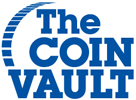Television show host is not an easy job. Think about it: whatever you are trying to get the audience to pay attention to, or in our case buy, is a task in itself regardless of the outcome. That particular task is only doable if the person on your television screen is knowledgeable about what they are talking about.
Enter Andy: The Coin Vault television host that not only knows what he is selling you but probably has known for years. That is the benefit of working at a family business such as this. Everyone here, in addition to our parent company SilverTowne, is steeped in knowledge. He has seen thousands of coins, if not hundreds of thousands, over the years. So when we asked him what his favorite of those thousands of coins he has seen over the years is, he is solid in his answer. Let us explore more in this continuation of “What’s Your Favorite Coin?” blog series.
The Winner: Saint Gaudens $10 Gold Indian (1907-1933)
“I think it’s the best looking American coin ever made in my opinion,” Andy said. “Sometimes you like either the obverse or the reverse of a coin. I love both sides.”
Although there are other denominations of Gold Indians in the $2.5 and $5 variety, there is something about Saint Gaudens relationship with President Theodore Roosevelt that seals the deal for the $10 variety.
“I like Pratt’s (Bela Lyon) designs for the Gold Indians but Saint Gaudens designed the $10 Indian for Roosevelt,” Andy explained. “What Roosevelt did for American coinage contributes to the way the US Mint still produces coins today. Roosevelt was demanding and he brought all these artists, like Saint Gaudens, Adolph A. Weinman, and James Earle Fraser, into the coin design world and those “old school designs” are still so influential. When I look at a $10 Gold Indian, I think about that highly regarded relationship between Roosevelt and Saint Gaudens.”
As far as owning a $10 Gold Indian, Andy perhaps has the best year you could own.
“I have a 1932 Philadelphia I believe,” he said, “which is the last year before they recalled all the gold in 1933 to melt during The Great Depression.”
For collectors looking to purchase one for their own hoard of coins, Andy believes that they are easily within arms reach if you are willing to do the research.
“If you like the design, there are a lot of examples out there that are extremely affordable,” he stated. “You can get one that is worth a little more than the intrinsic value.”
And just like his first choice, Roosevelt’s influence for the 1926 Oregon Trail Commemorative Half Dollar is Andy’s close second.
“Once again, the US Mint commissioned another designer due to Roosevelt's insistence of bringing over all these artists into the coin world,” Andy said. “Fraser designed the reverse while his wife (Laura) designed the obverse. Fraser would have never been involved if it weren’t for Roosevelt’s demands of having better looking U.S. coinage.”
